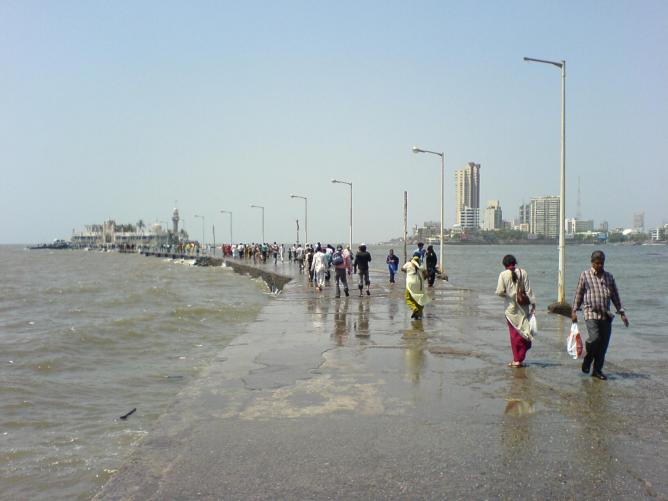Top 10 Architectural Sites to Visit in Mumbai

Tucked into corners and mixed in with busy streets, these sites in Mumbai show themselves demurely and spectacularly, reflecting the diverse cultures and religions that have flowed into India over the centuries. Culture Trip brings you ten architectural sites that you must visit next time you’re in India.

The Asiatic Library or the Town Hall
The Asiatic Library was built in the 19th century in a pristine neo-classical style, with stones apparently imported from England. It boasts a distinctive and imposing set of thirty steps, which lead to a Greek portico. The building is visually different from the heavier Gothic and Romanesque architecture mostly seen in heritage buildings built during the period. A high-ceilinged space can be found within, where readers can browse through the library’s reference section. Further in is a dramatic wrought-iron spiral staircase and marble statues of personages who contributed to the society. The library was built as a town hall for the walled city the British resided in, and also houses a museum.
The Asiatic Society Mumbai Town Hall, India

2. Art Deco Residences
Cinema
3. Bombay Arts Society
Art Gallery, Building
4. Kanheri Caves
Kanheri Caves
A vast complex of over a hundred caves, Kanheri dates from the second to the ninth century AD, and was a center for Buddhist worship. The caves are carved from basalt, and part of the experience of visiting them is the long and winding trails of steps that connect the caves. As opposed to Elephant Island, these caves have a grandeur that impresses with austerity rather than decoration. Most of the caves are quiet viharas intended for living and studying, and some are cisterns for water storage. The larger caves, known as chaityas, are for congregational worship and contain ornate sculptural carvings. They house Buddhist stupas, and the weighty pillars that typically line the cave sides form a long central path.
Kanheri Caves, Mumbai, India
 Haji Ali Causeway © Rakesh Krishna Kumar/WikiCommons
Haji Ali Causeway © Rakesh Krishna Kumar/WikiCommons5. Haji Ali Dargah
Mosque
6. Banganga Tank
Ruins

7. Chhatrapati Shivaji Maharaj Vastu Sangrahalay (formerly, The Prince Of Wales Museum)
Museum

8. Ranwar Village
Ranwar Village
Ranwar is a heritage village with written records from the early 1700s, though the village may have existed before then. Like the rest of Bandra, the suburb in which it is located, Ranwar was populated by Catholics, and continues to have largely Christian residents. Now fortressed by nondescript concrete structures, it nevertheless remains a quiet restful place to catch a glimpse into the world of old Bombay. Bungalows with sunlit verandas and gabled roofs covered in red Mangalorean tiles can be found along winding Veronica Street. They are also distinct in the white grillwork of their balconies and external staircases, and short square curtains tied back in the windows. It is said that in the old days villages houses stood open, and today you might still find someone relaxing in a veranda and ready for a chat.
Ranwar, Bandra West, Mumbai, India
 Bassein Fort © Gladson Machado/WikiCommons
Bassein Fort © Gladson Machado/WikiCommons9. Bassein Fort
Bassein Fort
Bassein Fort is located in Vasai, technically beyond the city, but it is only a few hours away and worth a day’s expedition. The Portuguese built it in the 16th century but fell to the Marathas in the 17th. The fort contained a large citadel, with several churches and water tanks, storehouses, an armory, and fields for vegetables. Several of the structures are still partially standing. Still visible are the remains of noble architecture, walls and decorative arches, stalwart columns and other decorative motifs. Many of the structures are now overgrown with vegetation, making it a pleasant place to wander through.
Bassein Fort, Mumbai, India
By Deborah Rosario
Since you are here, we would like to share our vision for the future of travel - and the direction Culture Trip is moving in.
Culture Trip launched in 2011 with a simple yet passionate mission: to inspire people to go beyond their boundaries and experience what makes a place, its people and its culture special and meaningful — and this is still in our DNA today. We are proud that, for more than a decade, millions like you have trusted our award-winning recommendations by people who deeply understand what makes certain places and communities so special.
Increasingly we believe the world needs more meaningful, real-life connections between curious travellers keen to explore the world in a more responsible way. That is why we have intensively curated a collection of premium small-group trips as an invitation to meet and connect with new, like-minded people for once-in-a-lifetime experiences in three categories: Culture Trips, Rail Trips and Private Trips. Our Trips are suitable for both solo travelers, couples and friends who want to explore the world together.
Culture Trips are deeply immersive 5 to 16 days itineraries, that combine authentic local experiences, exciting activities and 4-5* accommodation to look forward to at the end of each day. Our Rail Trips are our most planet-friendly itineraries that invite you to take the scenic route, relax whilst getting under the skin of a destination. Our Private Trips are fully tailored itineraries, curated by our Travel Experts specifically for you, your friends or your family.
We know that many of you worry about the environmental impact of travel and are looking for ways of expanding horizons in ways that do minimal harm - and may even bring benefits. We are committed to go as far as possible in curating our trips with care for the planet. That is why all of our trips are flightless in destination, fully carbon offset - and we have ambitious plans to be net zero in the very near future.












